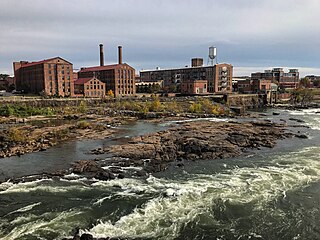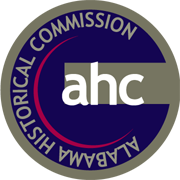
Chattahoochee County, also known as Cusseta-Chattahoochee County, is a county located on the western border in central Georgia. As of the 2020 census, the population was 9,565. The county seat is Cusseta, with which the county shares a consolidated city-county government. The city of Cusseta remains a geographically distinct municipality within Chattahoochee County. The county was created on February 13, 1854.
In the broadest sense, cultural resource management (CRM) is the vocation and practice of managing heritage assets, and other cultural resources such as contemporary art. It incorporates Cultural Heritage Management which is concerned with traditional and historic culture. It also delves into the material culture of archaeology. Cultural resource management encompasses current culture, including progressive and innovative culture, such as urban culture, rather than simply preserving and presenting traditional forms of culture.

Columbia is a town in Houston County, Alabama, United States. It is part of the Dothan, Alabama Metropolitan Statistical Area. At the 2010 census the population was 740, down from 804 in 2000.

Columbus is a consolidated city-county located on the west-central border of the U.S. state of Georgia. Columbus lies on the Chattahoochee River directly across from Phenix City, Alabama. It is the county seat of Muscogee County, with which it officially merged in 1970. Columbus is the second most populous city in Georgia, and fields the state's fourth-largest metropolitan area. At the 2020 census, Columbus had a population of 206,922, with 328,883 in the Columbus metropolitan area. The metro area joins the nearby Alabama cities of Auburn and Opelika to form the Columbus–Auburn–Opelika Combined Statistical Area, which had an estimated population of 486,645 in 2019.

The Chattahoochee River forms the southern half of the Alabama and Georgia border, as well as a portion of the Florida and Georgia border. It is a tributary of the Apalachicola River, a relatively short river formed by the confluence of the Chattahoochee and Flint rivers and emptying from Florida into Apalachicola Bay in the Gulf of Mexico. The Chattahoochee River is about 430 miles (690 km) long. The Chattahoochee, Flint, and Apalachicola rivers together make up the Apalachicola–Chattahoochee–Flint River Basin. The Chattahoochee makes up the largest part of the ACF's drainage basin.

The National Historic Preservation Act is legislation intended to preserve historic and archaeological sites in the United States of America. The act created the National Register of Historic Places, the list of National Historic Landmarks, and the State Historic Preservation Offices.
The Bankhead Highway was a United States cross-country automobile highway connecting Washington, D.C., and San Diego. The Bankhead Highway's beginnings can be traced back to 1916 when the Bankhead Highway Association was organized to promote the highway's development. It was part of the National Auto Trail system. The road was named for Alabama politician John H. Bankhead, a leader in the early national road-building movement. In later years, several stretches of U.S. Route 78 in northwest Alabama were renamed for Bankhead's son, former U.S. Representative and Speaker of the House William B. Bankhead.

A commemorative plaque, or simply plaque, or in other places referred to as a historical marker, historic marker, or historic plaque, is a plate of metal, ceramic, stone, wood, or other material, typically attached to a wall, stone, or other vertical surface, and bearing text or an image in relief, or both, to commemorate one or more persons, an event, a former use of the place, or some other thing. Many modern plaques and markers are used to associate the location where the plaque or marker is installed with the person, event, or item commemorated as a place worthy of visit. A monumental plaque or tablet commemorating a deceased person or persons, can be a simple form of church monument. Most modern plaques affixed in this way are commemorative of something, but this is not always the case, and there are purely religious plaques, or those signifying ownership or affiliation of some sort. A plaquette is a small plaque, but in English, unlike many European languages, the term is not typically used for outdoor plaques fixed to walls.

The Texas Historical Commission is an agency dedicated to historic preservation within the U.S. state of Texas. It administers the National Register of Historic Places for sites in Texas.
Hitchiti was a tribal town in what is now the Southeast United States. It was first known as part of the Apalachicola Province, an association of tribal towns along the Chattahoochee River. Shortly after 1690, the towns of Apalachicola Province moved to the central part of present-day Georgia, with Hitchiti joining most of those towns along Ochese Creek. In 1715, most of the towns on Ochese Creek, including Hitchiti, moved back to the Chattahoochee River, where the town remained until its people were forced to move to the Indian Territory as part of the Trail of Tears. Hitchiti was one of several towns whose people spoke the Hitchiti language.

The Georgia Historical Commission was an organization created by the U.S. state of Georgia for purposes of historic preservation. The Georgia legislature created it in February 1951 to promote and increase knowledge and understanding of the history of Georgia. Its work, including the erection of hundreds of historical markers, was accomplished during a relatively brief existence. These markers are still standing today. The impetus for the creation of the commission came from several sources as local historical societies were launching restoration projects of statewide importance.
Cusseta, also known as Kasihta, was a Peace Town of the Lower Towns, a division of the Muscogee Confederacy. It was located in what the Spanish called Apalachicola Province on the Chattahoochee River, then in what is now the state of Georgia near the Ocmulgee River, and finally again on the Chattahoochee River. It was one of the two major towns of the Lower Creek, with a population of 1,918 in 1832.

The Georgia Historical Society (GHS) is a statewide historical society in Georgia. Headquartered in Savannah, Georgia, GHS is one of the oldest historical organizations in the United States. Since 1839, the society has collected, examined, and taught Georgia history through a variety of educational outreach programs, publications, and research services.

The Alabama Historical Commission is the historic preservation agency for the U.S. state of Alabama. The agency was created by an act of the state legislature in 1966 with a mission of safeguarding Alabama's historic buildings and sites. It consists of twenty members appointed by the state governor or who serve in an official position. The members represent a broad cross section of Alabamians including architects, historians, archaeologists, and representatives of state universities. The commission is tasked with acquisition and preservation of historic properties and education of the public about historic sites in Alabama.
According to the Natural Resources Defense Council's recent study, Florida is one of 14 states predicted to face "high risk" water shortages by the year 2050. The state's water is primarily drawn from the Floridan Aquifer as well as from the St. Johns River, the Suwannee River, and the Ocklawaha River. Florida's regional water conflicts stem primarily from the fact that the majority of the fresh water supply is found in the rural north, while the bulk of the population, and therefore water consumption, resides in the south. Metropolitan municipalities in central and south Florida have neared their aquifer extraction limit of 650 million US gallons (2,500,000 m3) per day, leading to the search for new, extra-regional sources.

The tri-state water dispute is a 21st-century water-use conflict among the U.S. states of Georgia, Alabama, and Florida over flows in the Apalachicola-Chattahoochee-Flint River Basin and the Alabama-Coosa-Tallapoosa River Basin. The U.S. Army Corps of Engineers has regulated water flow for the entire Chattahoochee River, from Lake Lanier in Forsyth County, Georgia, to Alabama and Florida.

Thronateeska Heritage Center is a 501(c)3 not-for-profit organization incorporated in 1974 for the purpose of historic preservation and science education in Southwest Georgia. Thronateeska is located at Heritage Plaza, the 100 block of West Roosevelt Avenue in Albany, Georgia, United States.

The commemoration of the American Civil War is based on the memories of the Civil War that Americans have shaped according to their political, social and cultural circumstances and needs, starting with the Gettysburg Address and the dedication of the Gettysburg cemetery in 1863. Confederates, both veterans and women, were especially active in forging the myth of the Lost Cause of the Confederacy.
The Southwestern Pennsylvania Heritage Preservation Commission was a federal commission established within the United States Department of the Interior to oversee the America's Industrial Heritage Project. It was created in 1988 as a means for "recognizing, preserving, promoting, and interpreting the cultural heritage of the 9-county region in southwestern Pennsylvania associated with the three basic industries of iron and steel, coal, and transportation. The Commission sunset on November 18, 2008.
Acorn Creek is a stream in Carroll County in the U.S. state of Georgia, at an elevation of 666 feet (203 m) above mean sea level. It is a tributary to the Chattahoochee River with a discharge rate of 2.74 cfs.